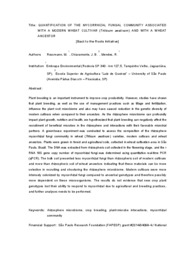Quantification of the mycorrhizal fungal community associated with a modern wheat cultivar (Triticum aestivum) and with a wheat ancestor.
Quantification of the mycorrhizal fungal community associated with a modern wheat cultivar (Triticum aestivum) and with a wheat ancestor.
Autoria: ROSSMANN, M.; CHIARAMONTE, J. B.; MENDES, R.
Resumo: Abstract: Plant breeding is an important instrument to improve crop productivity. However, studies have shown that plant breeding, as well as the use of management practices such as tillage and fertilization, influence the plant root microbiome and also may have caused reduction in the genetic diversity of modern cultivars when compared to their ancestors. As the rhizosphere microbiome can profoundly impact plant growth, nutrition and health, we hypothesized that plant breeding can negatively affect the recruitment of beneficial microbes in the rhizosphere and interactions with their favorable microbial partners. A greenhouse experiment was conducted to assess the composition of the rhizosphere mycorrhizal fungi community in wheat (Triticum aestivum) varieties, modern cultivars and wheat ancestors. Plants were grown in forest and agricultural soils, collected in wheat cultivation area in São Paulo, Brazil. The DNA was extracted from rhizospheric soil collected in the flowering stage, and the r RNA 18S gene copy number of mycorrhizal fungi was determined using quantitative real-time PCR (qPCR). The bulk soil presented less mycorrhizal fungi than rhizospheric soil of modern cultivars and more than rhizospheric soil of wheat ancestors indicating that these materials can be more selective in recruiting and structuring the rhizosphere microbiome. Modern cultivars were more intensely colonized by mycorrhizal fungi compared to ancestral genotypes and therefore possibly more dependent on these microorganisms. The results do not evidence that new crop plant genotypes lost their ability to respond to mycorrhizal due to agricultural and breeding practices, and further analyses needs to be performed.
Ano de publicação: 2015
Tipo de publicação: Resumo em anais e proceedings
Unidade: Embrapa Meio Ambiente
Palavras-chave: Crop breeding, Mycorrhizal community, Plant-microbe interactions, Rhizosphere microbiome, Trigo, Triticum Aestivum
Observações
1 - Por padrão são exibidas publicações dos últimos 20 anos. Para encontrar publicações mais antigas, configure o filtro ano de publicação, colocando o ano a partir do qual você deseja encontrar publicações. O filtro está na coluna da esquerda na busca acima.
2 - Para ler algumas publicações da Embrapa (apenas as que estão em formato ePub), é necessário ter, no celular ou computador, um desses softwares gratuitos. Sistemas Android: Google Play Livros; IOS: iBooks; Windows e Linux: software Calibre.
Acesse outras publicações
Acesse a Base de Dados da Pesquisa Agropecuária (BDPA) para consultar o acervo completo das bibliotecas da Embrapa.

